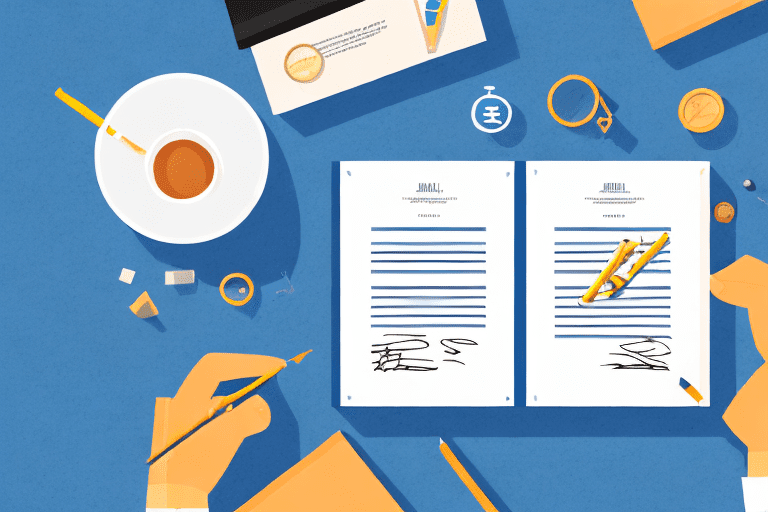In the world of intellectual property, licensing agreements play a crucial role in protecting the rights of inventors and creators. However, there are instances when these agreements are breached, leading to legal disputes and potential consequences. To understand the complexities surrounding licensing agreement breaches, it is essential to delve into the intricacies of patents, the Manual of Patent Examining Procedure (MPEP), and the Patent Bar exam. By exploring these topics, we can gain valuable insights into the legal implications and processes involved.
Understanding Licensing Agreements
Before we explore licensing agreement breaches, let’s first establish a solid foundation of understanding regarding these agreements. At its core, a licensing agreement is a legal contract between the intellectual property rights holder (licensor) and another party (licensee). This contract grants the licensee the authority to use, manufacture, sell, or distribute the licensor’s patented invention or copyrighted work.
Within licensing agreements, several key terms are commonly used. These terms outline the rights and obligations of both parties. For instance, the licensor may define the scope of the license, the geographical territory where it is valid, and any limitations or restrictions on usage.
Licensing agreements hold paramount significance, particularly in the realm of patent law. They enable inventors to share their inventions with others while ensuring they retain control over their intellectual property. Additionally, licensing agreements serve as a source of income for inventors, as they often require licensees to pay royalties or upfront fees.
Now, let’s delve deeper into the intricacies of licensing agreements. One important aspect to consider is the duration of the agreement. Licensing agreements can be either perpetual or for a specific term. In perpetual agreements, the license remains in effect indefinitely, unless terminated by either party. On the other hand, term-based agreements have a fixed duration, after which the license expires.
Another crucial element in licensing agreements is the issue of exclusivity. An exclusive license grants the licensee sole rights to use and exploit the licensed intellectual property, excluding all others, including the licensor. This type of license is often sought after by licensees who wish to gain a competitive advantage in the market. Conversely, non-exclusive licenses allow multiple licensees to use the intellectual property simultaneously.
Furthermore, licensing agreements may include provisions for sublicensing. Sublicensing occurs when the original licensee grants permission to a third party to use the licensed intellectual property. This provision can be beneficial for both the original licensee, who can generate additional revenue, and the sublicensee, who gains access to valuable intellectual property.
It is essential to address the issue of breach in licensing agreements. A breach occurs when either the licensor or licensee fails to fulfill their obligations as outlined in the contract. Breaches can range from failure to pay royalties or fees to unauthorized use or distribution of the licensed intellectual property. In such cases, the non-breaching party may seek legal remedies, such as termination of the agreement or monetary damages.
In conclusion, licensing agreements are intricate legal contracts that grant the licensee the authority to use, manufacture, sell, or distribute the licensor’s intellectual property. They play a crucial role in protecting and monetizing inventions and copyrighted works. Understanding the various terms and provisions within these agreements is essential for both licensors and licensees to ensure a mutually beneficial and legally sound relationship.
What Constitutes a Licensing Agreement Breach?
Despite the careful drafting of licensing agreements, breaches can still occur. A breach typically arises when either party fails to fulfill its obligations as outlined in the contract. Identifying breaches in licensing agreements requires a thorough examination of the agreement terms and the actions of the parties involved.
When a breach is suspected, legal consequences may follow. These consequences can range from monetary damages to injunctive relief, effectively preventing the breaching party from continuing to use the intellectual property. The severity of the consequences depends on various factors, including the nature of the breach and the extent of the resulting harm.
In order to fully understand the complexities of licensing agreement breaches, it is important to delve into the different types of breaches that can occur. One common type of breach is known as a material breach. This occurs when one party fails to perform a significant obligation stated in the agreement. For example, if a licensee fails to make the required royalty payments to the licensor, it would be considered a material breach.
Another type of breach is a non-material breach, also known as a minor breach. This occurs when a party fails to perform a less significant obligation stated in the agreement. For instance, if a licensee fails to provide quarterly reports on the use of the licensed intellectual property, it would be considered a non-material breach.
Furthermore, breaches can be categorized as anticipatory or actual. An anticipatory breach occurs when one party clearly indicates that they will not fulfill their obligations under the agreement. This can be demonstrated through explicit statements or actions that make it evident that the party does not intend to perform as required. On the other hand, an actual breach occurs when a party fails to perform their obligations within the agreed-upon time frame or in the manner specified in the agreement.
It is important to note that not all breaches are intentional or malicious. Sometimes, breaches can occur due to unforeseen circumstances or misunderstandings between the parties. In such cases, it may be possible to resolve the breach through negotiation and finding a mutually beneficial solution.
When a breach is identified, it is crucial to carefully review the licensing agreement to determine the appropriate course of action. This may involve seeking legal advice to understand the rights and remedies available under the agreement and applicable laws. Additionally, documenting the breach and gathering evidence to support any claims or defenses is essential in the event of litigation or dispute resolution.
In conclusion, licensing agreement breaches can have significant consequences for both parties involved. Understanding the different types of breaches and their implications is essential for effectively addressing and resolving such issues. By being aware of the potential breaches that can occur and taking proactive measures to prevent them, parties can minimize the risks and ensure a smoother and more successful licensing relationship.
An Overview of Patents
Understanding patents is essential when examining licensing agreement breaches, as patents are often the subject of these agreements. A patent is a form of intellectual property protection granted by a government authority to inventors, giving them exclusive rights over their inventions for a specified period. These exclusive rights enable inventors to prevent others from making, using, or selling their patented inventions without authorization.
Obtaining a patent involves a thorough and rigorous process that requires inventors to demonstrate the uniqueness, usefulness, and non-obviousness of their invention. This process begins with the inventor filing a patent application with the appropriate government authority, such as the United States Patent and Trademark Office (USPTO). The application must include a detailed description of the invention, including its technical specifications and any supporting documentation.
Once the patent application is filed, it undergoes a review process by patent examiners who specialize in the relevant field of technology. These examiners carefully evaluate the invention to determine if it meets the criteria for patentability. They conduct a comprehensive search of existing patents, scientific literature, and other sources to ensure that the invention is novel and non-obvious.
If the patent examiners find the invention to be novel and non-obvious, they may grant a patent to the inventor. However, if they determine that the invention lacks novelty or is obvious in light of existing knowledge, they may reject the application. In such cases, the inventor has the opportunity to amend the application or provide additional arguments to overcome the examiner’s objections.
Once granted, a patent provides inventors with the legal framework to safeguard their ideas and inventions from unauthorized use. It gives them the right to exclude others from making, using, or selling their patented inventions without permission. This exclusivity allows inventors to capitalize on their innovations by licensing their patents to other parties, who can then use the patented technology in exchange for royalties or other financial arrangements.
Patents play a crucial role in promoting innovation and technological advancement. They incentivize inventors to invest time, effort, and resources into developing new and groundbreaking inventions by providing them with a period of exclusivity. This exclusivity allows inventors to recoup their investment and profit from their inventions, which in turn encourages further research and development.
However, the patent system is not without its challenges and criticisms. Some argue that patents can stifle competition and hinder progress by granting inventors a monopoly over their inventions. Others claim that the patent examination process can be lengthy and costly, making it difficult for small inventors and startups to secure patent protection.
Despite these challenges, patents remain a vital tool for protecting intellectual property and fostering innovation. They provide inventors with the legal means to safeguard their ideas and inventions, ensuring that they can reap the rewards of their creativity and ingenuity. As technology continues to advance at a rapid pace, patents will continue to play a crucial role in shaping the future of innovation.
The Manual of Patent Examining Procedure (MPEP)
To navigate the complex world of patents, the Manual of Patent Examining Procedure (MPEP) serves as a comprehensive guide. The MPEP outlines the rules and procedures followed by patent examiners at the United States Patent and Trademark Office (USPTO).
Understanding the MPEP is crucial for both patent applicants and examiners. For applicants, it provides valuable insights into the examination process, helping them navigate the intricacies of obtaining a patent. For examiners, it acts as a reference, guiding them in assessing patent applications, ensuring adherence to legal requirements and prior art considerations.
The Patent Bar: An Essential Aspect of Patent Law
At the heart of patent law lies the Patent Bar, an examination administered by the USPTO. Passing this exam is a prerequisite for individuals seeking to practice patent law before the USPTO and represent clients in matters related to patents. The Patent Bar encompasses a wide range of legal and technical knowledge, making it a rigorous and challenging test.
The Patent Bar plays a vital role in ensuring that individuals practicing patent law possess the necessary expertise to navigate the complexities of intellectual property litigation, licensing agreements, and patent prosecution. Preparing for this exam requires a deep understanding of patent law, the MPEP, and the various legal and technical aspects related to patents.
Conclusion
In conclusion, understanding licensing agreement breaches requires exploring crucial components of patent law, such as patents themselves, the Manual of Patent Examining Procedure (MPEP), and the Patent Bar exam. Licensing agreements form the basis for sharing intellectual property while protecting the rights of inventors and creators. When these agreements are breached, legal consequences may arise, necessitating a comprehensive understanding of patents, the MPEP, and the complexities of the Patent Bar exam. By comprehending these key concepts, we can navigate the intricate landscape of intellectual property law with confidence and diligence.






